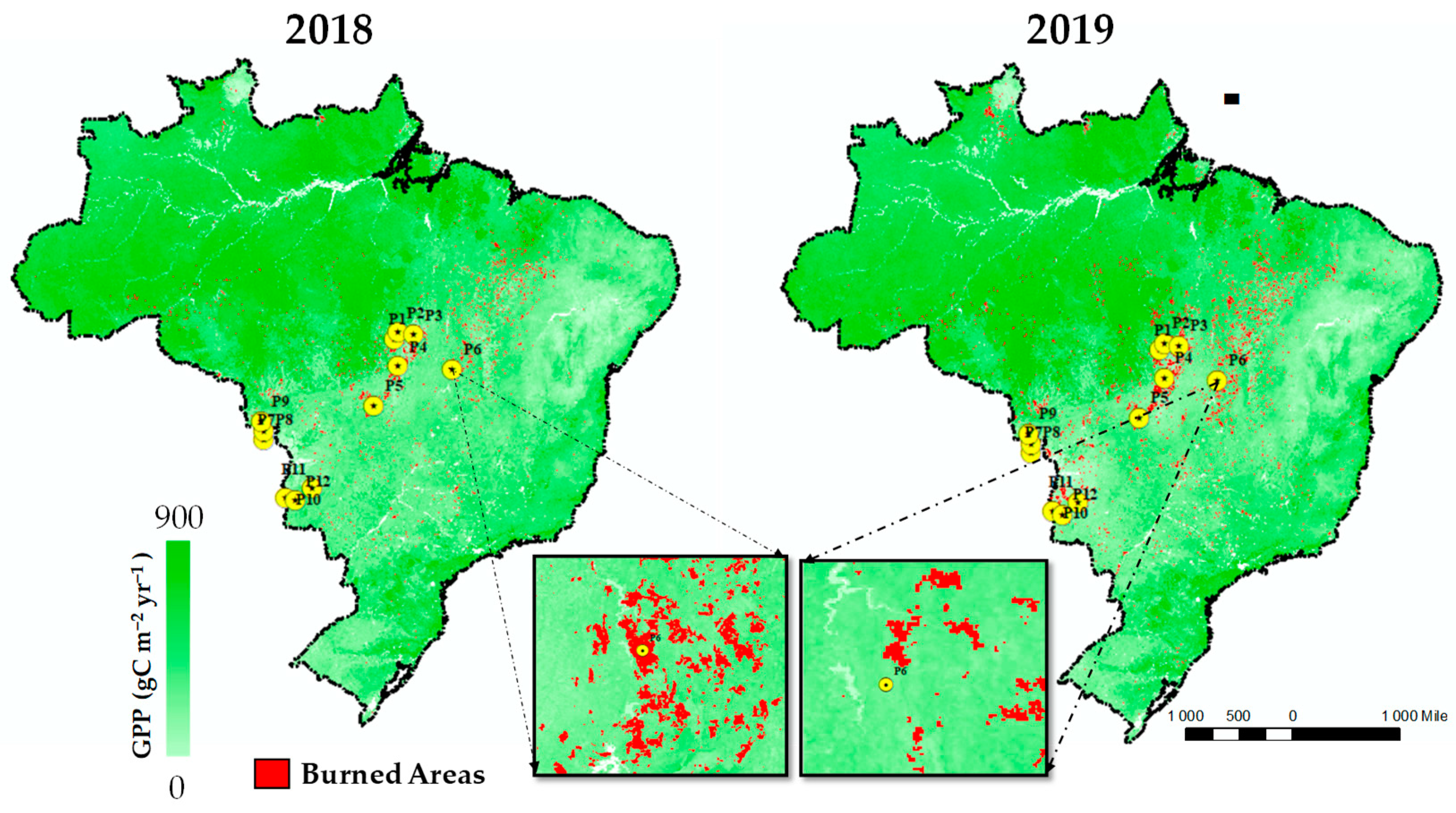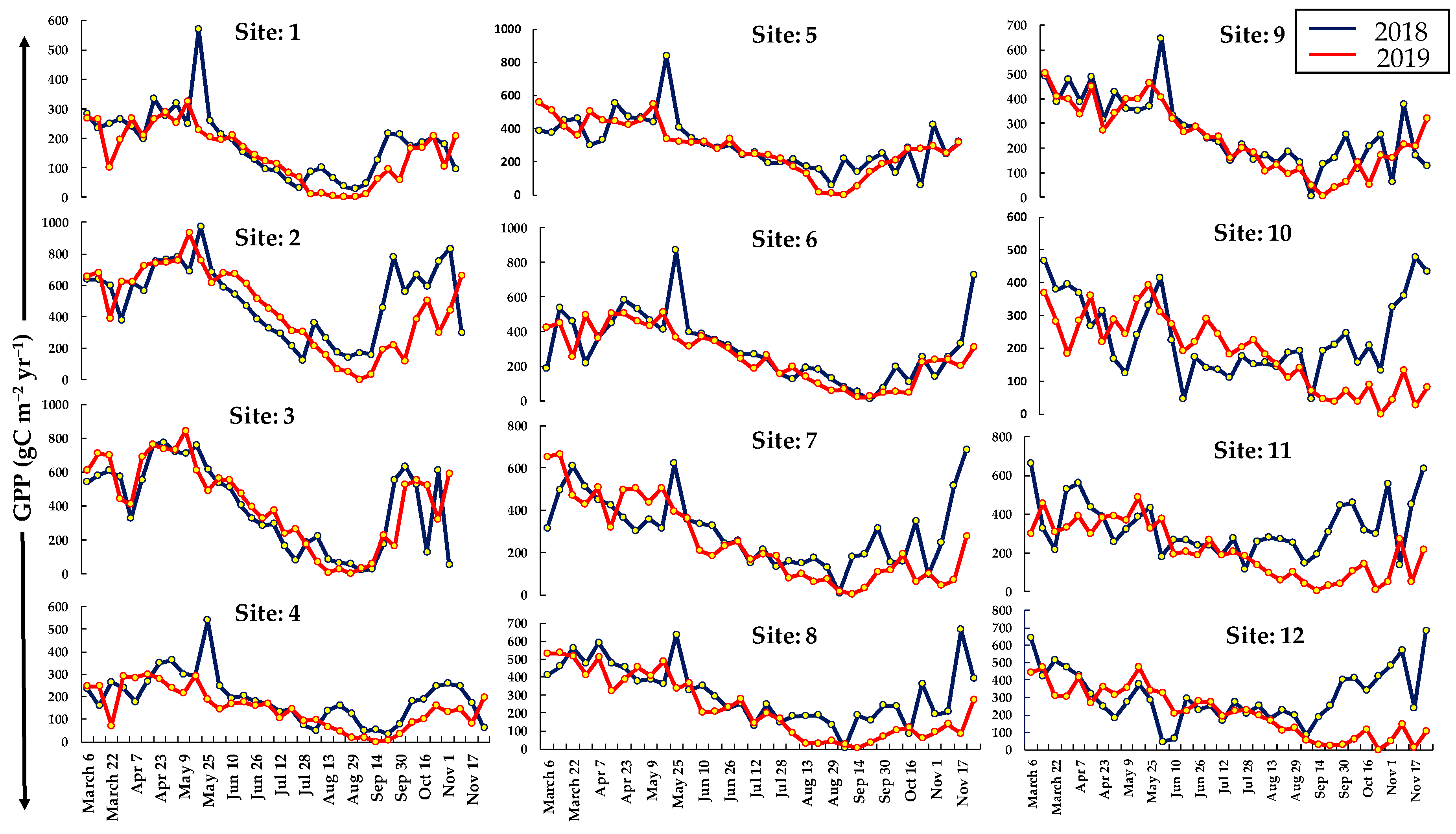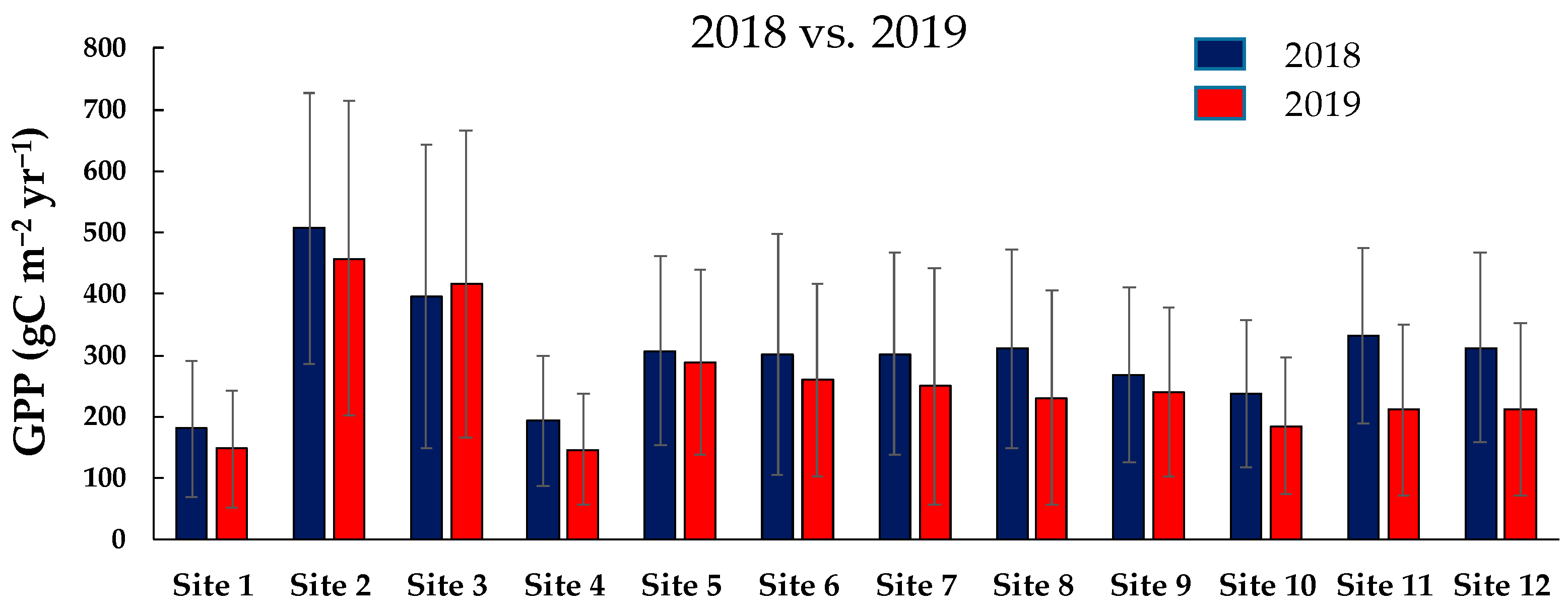Amazonian Fire Events Disturbed the Global Carbon Cycle: A Study from 2019 Amazon Wildfire Using Google Earth Engine †
Abstract
:1. Introduction
2. Study Area
3. Materials and Methods
3.1. Datasets
3.2. Methods
4. Result and Discussion
4.1. Result
4.2. Discussion
5. Conclusions
Author Contributions
Funding
Data Availability Statement
Acknowledgments
Conflicts of Interest
References
- Bonilla-Bedoya, S.; Estrella-Bastidas, A.; Molina, J.R.; Herrera, M.Á. Socioecological system and potential deforestation in Western Amazon forest landscapes. Sci. Total Environ. 2018, 644, 1044–1055. [Google Scholar] [CrossRef] [PubMed]
- Cotrina Sánchez, D.A.; Barboza Castillo, E.; Rojas Briceño, N.B.; Oliva, M.; Torres Guzman, C.; Amasifuen Guerra, C.A.; Bandopadhyay, S. Distribution Models of Timber Species for Forest Conservation and Restoration in the Andean-Amazonian Landscape, North of Peru. Sustainability 2020, 12, 7945. [Google Scholar] [CrossRef]
- Meza M., G.; Barboza C., E.; Torres G., C.; Cotrina S., D.A.; Guzman V., B.K.; Oliva, M.; Bandopadhyay, S.; Salas L., R.; Rojas B., N.B. Predictive Modelling of Current and Future Potential Distribution of the Spectacled Bear (Tremarctos ornatus) in Amazonas, Northeast Peru. Animals 2020, 10, 1–21. [Google Scholar]
- d’Annunzio, R.; Sandker, M.; Finegold, Y.; Min, Z. Projecting global forest area towards 2030. For. Ecol. Manage. 2015, 352, 124–133. [Google Scholar] [CrossRef]
- Silva Junior, C.H.L.; Celentano, D.; Rousseau, G.X.; de Moura, E.G.; Varga, I. van D.; Martinez, C.; Martins, M.B. Amazon forest on the edge of collapse in the Maranhão State, Brazil. Land Use Policy 2020, 97, 104806. [Google Scholar] [CrossRef]
- Barlow, J.; Berenguer, E.; Carmenta, R.; França, F. Clarifying Amazonia’s burning crisis. Glob. Chang. Biol. 2020, 26, 319–321. [Google Scholar] [CrossRef] [PubMed]
- Gerwing, J.J. Degradation of forests through logging and fire in the eastern Brazilian Amazon. For. Ecol. Manage. 2002, 157, 131–141. [Google Scholar] [CrossRef]
- Kauffman, J.B.; Cummings, D.L.; Ward, D.E.; Babbitt, R. Fire in the Brazilian Amazon: 1. Biomass, nutrient pools, and losses in slashed primary forests. Oecologia 1995, 104, 397–408. [Google Scholar] [CrossRef] [PubMed]
- Hughes, R.F.; Kauffman, J.B.; Cummings, D.L. Fire in the Brazilian Amazon. Oecologia 2000, 124, 574–588. [Google Scholar] [CrossRef] [PubMed]
- Schulze, M.D. Forest fires in the Brazilian Amazon. Conserv. Biol. 1998, 12, 948–950. [Google Scholar]
- Nepstad, D.; Moreira, A.; Veríssimo, A.; Lefebvre, P.; Schlesinger, P.; Potter, C.; Nobre, C.; Setzer, A.; Krug, T.; Barros, A.C.; et al. Forest fire prediction and prevention in the Brazilian Amazon. Conserv. Biol. 1998, 12, 951–953. [Google Scholar] [CrossRef]
- Delgado, R.C.; Pereira, M.G.; Teodoro, P.E.; dos Santos, G.L.; de Carvalho, D.C.; Magistrali, I.C.; Vilanova, R.S. Seasonality of gross primary production in the Atlantic Forest of Brazil. Glob. Ecol. Conserv. 2018, 14, e00392. [Google Scholar] [CrossRef]
- Pinnington, E.M.; Casella, E.; Dance, S.L.; Lawless, A.S.; Morison, J.I.L.; Nichols, N.K.; Wilkinson, M.; Quaife, T.L. Understanding the effect of disturbance from selective felling on the carbon dynamics of a managed woodland by combining observations with model predictions. J. Geophys. Res. Biogeosci. 2017, 122, 886–902. [Google Scholar] [CrossRef]
- Amiro, B.D.; Barr, A.G.; Barr, J.G.; Black, T.A.; Bracho, R.; Brown, M.; Chen, J.; Clark, K.L.; Davis, K.J.; Desai, A.R.; et al. Ecosystem carbon dioxide fluxes after disturbance in forests of North America. J. Geophys. Res. Biogeosci. 2010, 115. [Google Scholar] [CrossRef]
- Frank, D.; Reichstein, M.; Bahn, M.; Thonicke, K.; Frank, D.; Mahecha, M.D.; Smith, P.; van der Velde, M.; Vicca, S.; Babst, F.; et al. Effects of climate extremes on the terrestrial carbon cycle: Concepts, processes and potential future impacts. Glob. Chang. Biol. 2015, 21, 2861–2880. [Google Scholar] [PubMed]
- Bandopadhyay, S.; Rastogi, A.; Juszczak, R. Review of top-of-canopy sun-induced fluorescence (Sif) studies from ground, uav, airborne to spaceborne observations. Sensors (Switzerland) 2020, 20, 1144. [Google Scholar]
- Ciais, P.; Reichstein, M.; Viovy, N.; Granier, A.; Ogée, J.; Allard, V.; Aubinet, M.; Buchmann, N.; Bernhofer, C.; Carrara, A.; et al. Europe-wide reduction in primary productivity caused by the heat and drought in 2003. Nature 2005, 437, 529–533. [Google Scholar] [PubMed]





| Spots | Coordinates (W, S) | Reference Places |
|---|---|---|
| P1 | −51.45, −11.14 | Luciará (Mato Grosso, Brazil) |
| P2 | −51.21, −10.74 | Porto Alegre o Norte (Mato Groso, Brazil) |
| P3 | −50.33, −10.90 | Inawebohona (Tocantis, Brazil) |
| P4 | −51.22, −12.74 | Ribeirão Cascalheira (Mato Grosso, Brazil) |
| P5 | −52.68, −15.02 | Novo Sao Joaquim (Mato Grosso, Brazil) |
| P6 | −48.04, −12.90 | Paraná (Tocantis, Brazil) |
| P7 | −59.14, −17.02 | San Matías (Brazil–Bolivia border) |
| P8 | −59.12, −16.53 | San Matías (Brazil–Bolivia border) |
| P9 | −59.29, −15.95 | Porto Esperidião (Mato Grosso, Brazil) |
| P10 | −57.84, −20.41 | Corumbá (Mato Grosso del Sur,Brazil) |
| P11 | −56.31, −19.88 | Miranda (Mato Grosso del Sur, Brazil) |
| P12 | −57.26, −20.60 | Kadiwéu (Porto Murtinho; Mato Grosso del Sur, Brazil) |
Publisher’s Note: MDPI stays neutral with regard to jurisdictional claims in published maps and institutional affiliations. |
© 2020 by the authors. Licensee MDPI, Basel, Switzerland. This article is an open access article distributed under the terms and conditions of the Creative Commons Attribution (CC BY) license (https://creativecommons.org/licenses/by/4.0/).
Share and Cite
Bandopadhyay, S.; Sánchez, D.A.C. Amazonian Fire Events Disturbed the Global Carbon Cycle: A Study from 2019 Amazon Wildfire Using Google Earth Engine. Environ. Sci. Proc. 2021, 3, 43. https://doi.org/10.3390/IECF2020-08033
Bandopadhyay S, Sánchez DAC. Amazonian Fire Events Disturbed the Global Carbon Cycle: A Study from 2019 Amazon Wildfire Using Google Earth Engine. Environmental Sciences Proceedings. 2021; 3(1):43. https://doi.org/10.3390/IECF2020-08033
Chicago/Turabian StyleBandopadhyay, Subhajit, and Dany A. Cotrina Sánchez. 2021. "Amazonian Fire Events Disturbed the Global Carbon Cycle: A Study from 2019 Amazon Wildfire Using Google Earth Engine" Environmental Sciences Proceedings 3, no. 1: 43. https://doi.org/10.3390/IECF2020-08033
APA StyleBandopadhyay, S., & Sánchez, D. A. C. (2021). Amazonian Fire Events Disturbed the Global Carbon Cycle: A Study from 2019 Amazon Wildfire Using Google Earth Engine. Environmental Sciences Proceedings, 3(1), 43. https://doi.org/10.3390/IECF2020-08033







